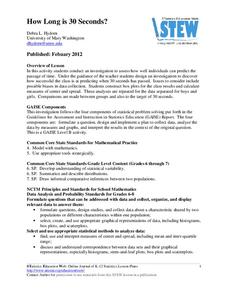American Statistical Association
How Long is 30 Seconds?
Is time on your side? Pupils come up with an experiment to test whether their classmates can guess how long it takes for 30 seconds to elapse. They divide the class data into two groups, create box-and-whisker plots, and analyze the...
Curated OER
Nutrition and the Media: Cereal Box Consumerism
How many treats do you buy each week? Learners investigate diets and how the media tricks consumers into purchasing unhealthy snacks. They will investigate the designs and logos affiliated with cereal boxes and identify specific phrases...
Curated OER
Advance Notice
We often wait until adulthood to start analyzing learning styles. This informative and interesting presentation delves into how we learn. It is a quick and insightful look at how students perform in school. The information could be...
NASA
Making Oxygen and Carbon Dioxide
Some like it hot! Scholars observe both exothermic and endothermic reactions as part of the carbon dioxide oxygen cycle. First, scientists demonstrate (or watch) a chemical reaction to create pure oxygen using fire for...
Curated OER
Dragonfly
The speed of a dragonfly brings math into the real world as your learners collaboratively see the value in calculating unit rates in direct proportion problems. This six-phase lesson encourages you, as the teacher, to only ask questions...
Illustrative Mathematics
Sammy's Chipmunk and Squirrel Observations
Here is a fun project. Sammy observes a chipmunk and a squirrel to see how many holes each needs in order to stash the same number of acorns. Scholars could find the answer algebraically or create a table to analyze the...
EngageNY
When Can We Reverse a Transformation? 2
The second lesson on finding inverse matrices asks class members to look for a pattern in the inverse matrix and test it to see if it works for all matrices. The teacher leads a discussion to refine the process in finding inverses,...
EngageNY
Matrix Addition Is Commutative
Explore properties of addition as they relate to matrices. Using graphical representations of vector matrices, scholars test the commutative and associative properties of addition. They determine if the properties are consistent for...
EngageNY
Estimating Probability Distributions Empirically 2
Develop probability distributions from simulations. Young mathematicians use simulations to collect data. They use the data to draw graphs of probability distributions for the random variable in question.
EngageNY
Applications of the Pythagorean Theorem
Examine the application of the Pythagorean Theorem in problem-solving questions. Pupils apply the theorem to find lengths when given different scenarios. They finish the 17th installment in an 18-part series by applying the theorem...
EngageNY
From Equations to Inequalities
Sometimes, equality just doesn't happen. Scholars apply their knowledge of solving equations to identify values that satisfy inequalities in the 34th installment of a 36-part module. They test given sets of numbers to find those that are...
Florida International University
Design Your Own
Apply scientific principles to designing an experiment to study organisms living on the coral reef in our oceans. Through reading, individuals learn about the coral reef ecosystem and important factors that affect its function....
C-SPAN
Judicial Review and Marbury v Madison
The Supreme Court case Marbury v. Madison may not be widely recognized but the landmark case is particularly significant because it established the precedent for judicial review and that the Supreme Court had power as an interpreter of...
BioEd Online
Muscle Fibers
What better way to learn about muscle than by dissecting one? Using cow muscle (beef), learners compare bundles of yarn to muscle fibers as they explore each. The supplemental reading about astronauts losing muscle mass in space and what...
PBS
Curious George: Fan and Blow
What kind of wind works best to make things move? After watching a short video from Curious George, super scientists answer the question by testing various wind-making tools. Learners observe, record, and share their findings.
Curated OER
Challenges of the new SAT
Students write a news feature about the changes of the SAT and how students can best cope with them. Students respond to several questions addressing the new SAT. Students research about the changes in the test, and students interview...
Curated OER
What to do Between AP Exams and Semester Finals
Trying to write your end-of-year exam while encouraging scholars to begin reviewing? Do both using this study-skills strategy, which has scholars writing their own test! Although this lesson plan is intended for AP classes, it is...
Curated OER
Volleyball - Lesson One
How much does your class know about volleyball? Start your volleyball unit with a written pre-test on the skills and rules of the sport. Then, give them a handout that teaches the class all about volleyball. Try breaking the...
Curated OER
Identification of Gram Negative Bacilli-IMViC
For this microbiology worksheet, students complete 9 review questions after finishing a group lab in which they perform four biochemical tests to help divide the Enterobacteriaceae into two major groups- E. coli and...
Curated OER
Is Our Water Healthy?
High schoolers test water for a least one chemical characteristic. They hypothesize how a storm event might change the chemical characteristics of a stream. Students collect water samples and use the chemical test to test the water.
Curated OER
Regents High School Examination GEOMETRY 2009
The University of New York Regents High School Exam for geometry from August 2009 is comprehensive in scope with 38 questions over 22 pages. Geometers can assess their mastery of core content with a combination of multiple choice and...
Curated OER
Review Game
Students of all ages and subjects can participate in this review game. They are given a note card with a question or problem. The game is over when students have no more questions to answer.
Brigham Young University
Socratic Seminar for Cold Sassy Tree
Tired of giving the same old multiple-choice tests, and have the urge for a new assessment? Then bring the precision of a Socratic seminar into your classroom. Even if you did not read Cold Sassy Tree the organization and explanation on...
Curated OER
Using Context Clues
Middle schoolers receive a handout that lists the five types of context clues. The class divides up into groups of three or four, and each group chooses five unfamiliar words. They write a multiple-choice question for each of their five...
Other popular searches
- Water Cycle Test Questions
- Annabel Lee Test Questions
- Weather Test Questions
- Test Questions Benchmarks
- Forgery Test Questions
- Ged Test Math Questions
- Civil War Test Questions
- Ecology Test Questions
- Vocabulary Test Questions
- Identifying Test Questions
- Africa Test Questions
- Genetics Test Questions























